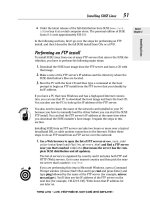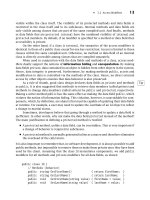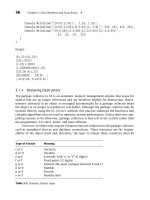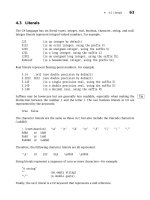TCP/IP Sockets in C# Practical Guide for Programmers phần 2 pptx
Bạn đang xem bản rút gọn của tài liệu. Xem và tải ngay bản đầy đủ của tài liệu tại đây (105.01 KB, 19 trang )
■
1.6 Exercises 7
Applications
Socket references
Sockets bound to ports
TCP sockets UDP sockets
TCP ports UDP ports
TCP
UDP
IP
1 2 65535
…
……
…
1 2 65535
… …
Figure 1.2: Sockets, protocols, and ports.
Figure 1.2 depicts the logical relationships among applications, socket abstractions,
protocols, and port numbers within a single host. Note that a single socket abstraction
can be referenced by multiple application programs. Each program that has a reference
(called a descriptor) to a particular socket can communicate through that socket. Earlier
we said that a port identifies an application on a host. Actually, a port identifies a socket
on a host. Figure 1.2 shows that multiple programs on a host can access the same socket.
In practice, separate programs that access the same socket would usually belong to the
same application (e.g., multiple copies of a Web server program), although in principle
they could belong to different applications.
1.6 Exercises
1. Can you think of a real-life example of communication that does not fit the client-
server model?
2. To how many different kinds of networks is your home connected? How many
support two-way communication?
3. IP is a best-effort protocol, requiring that information be broken down into data-
grams, which may be lost, duplicated, or reordered. TCP hides all of this, providing
a reliable service that takes and delivers an unbroken stream of bytes. How might
you go about providing TCP service on top of IP? Why would anybody use UDP when
TCP is available?
This Page Intentionally Left Blank
chapter 2
Basic Sockets
You are now ready to learn to write your own socket applications in C#. One of the
advantages of the C# programming language is its use of Microsoft’s .NET framework,
which provides a powerful library of APIs for programming. Among the class libraries pro-
vided are the System.Net and System.Net.Sockets namespaces, and most of this book is
dedicated to how to use the socket APIs provided there. In this chapter we begin by demon-
strating how C# applications identify network hosts. Then, we describe the creation of TCP
and UDP clients and servers. The .NET framework provides a clear distinction between
using TCP and UDP, defining a separate set of classes for both protocols, so we treat each
separately. Finally, we discuss the Socket class that is the underlying implementation of
all the higher level .NET socket classes.
2.1 Socket Addresses
IPv4 uses 32-bit binary addresses to identify communicating hosts. A client must specify
the IP address of the host running the server program when it initiates communication; the
network infrastructure uses the 32-bit destination address to route the client’s information
to the proper machine. Addresses can be specified in C# by their 32-bit long integer value or
by using a string that contains the dotted-quad representation of the numeric address (e.g.,
169.1.1.1). .NET encapsulates the IP addresses abstraction in the IPAddress class which can
take a long integer IP argument in its constructor, or process a string with the dotted-quad
representation of an IP address using its Parse() method. The Dns class also provides
a mechanism to look up, or resolve, names to IP addresses (e.g., server.example.com).
Since in the modern Internet it is not uncommon for a single server to resolve to multiple
9
10 Chapter 2: Basic Sockets
■
IP addresses or name aliases, the results are returned in a container class IPHostEntry,
which contains an array of one or more string host names and IPAddress class instances.
The Dns class has several methods for resolving IP addresses. The GetHostName()
method takes no arguments and returns a string containing the local host name. The
GetHostByName() and Resolve() methods are basically identical; they take a string argu-
ment containing the host name to be looked up and returns the IP address and host name
information for the supplied input in the form of an IPHostEntry class instance. The Get-
HostByAddress() method takes a string argument containing the dotted-quad string rep-
resentation of an IP address and also returns host information in an IPHostEntry instance.
Our first program example, IPAddressExample.cs, demonstrates the use of the Dns,
IPAddress, and IPHostEntry classes. The program takes a list of names or IP addresses as
command-line parameters and prints the name and an IP address of the local host, followed
by the names and IP addresses of the hosts specified on the command line.
IPAddressExample.cs
0 using System; // For String and Console
1 using System.Net; // For Dns, IPHostEntry, IPAddress
2 using System.Net.Sockets; // For SocketException
3
4 class IPAddressExample {
5
6 static void PrintHostInfo(String host) {
7
8 try {
9 IPHostEntry hostInfo;
10
11 // Attempt to resolve DNS for given host or address
12 hostInfo = Dns.Resolve(host);
13
14 // Display the primary host name
15 Console.WriteLine("\tCanonical Name: " + hostInfo.HostName);
16
17 // Display list of IP addresses for this host
18 Console.Write("\tIP Addresses: ");
19 foreach (IPAddress ipaddr in hostInfo.AddressList) {
20 Console.Write(ipaddr.ToString()+"");
21 }
22 Console.WriteLine();
23
24 // Display list of alias names for this host
25 Console.Write("\tAliases: ");
26 foreach (String alias in hostInfo.Aliases) {
■
2.1 Socket Addresses 11
27 Console.Write(alias+"");
28 }
29 Console.WriteLine("\n");
30 } catch (Exception) {
31 Console.WriteLine("\tUnable to resolve host:"+host+"\n");
32 }
33 }
34
35 static void Main(string[] args) {
36
37 // Get and print local host info
38 try {
39 Console.WriteLine("Local Host:");
40 String localHostName = Dns.GetHostName();
41 Console.WriteLine("\tHost Name: " + localHostName);
42
43 PrintHostInfo(localHostName);
44 } catch (Exception) {
45 Console.WriteLine("Unable to resolve local host\n");
46 }
47
48 // Get and print info for hosts given on command line
49 foreach (String arg in args) {
50 Console.WriteLine(arg + ":");
51 PrintHostInfo(arg);
52 }
53 }
54 }
IPAddressExample.cs
1. PrintHostInfo(): look up host/address/alias info for the host name argument
and print it to the console: lines 6–33
■
Retrieve an IPHostEntry class instance for the specified host: lines 11–12
Call Dns.Resolve() with the host name argument. If successful, hostInfo will
reference an IPHostEntry class instance containing information for the specified
host. If the lookup fails, code execution will drop to the catch block on lines
30–32.
■
Print the canonical name: lines 14–15
DNS allows a host name to have one “canonical” or true name and zero or
more aliases. The canonical name is populated in the HostName property of the
IPHostEntry.
12 Chapter 2: Basic Sockets
■
■
Display the list of IP address(es): lines 17–22
Loop through all the IP address(es) contained in the AddressList property, which
is an array of IPAddress class instances.
■
Display the list of alias host names: lines 24–29
Loop through any host name aliases contained in the Aliases property, which is
an array of Strings. If a host name being looked up does not have any aliases, this
array will be empty.
2. Print information about the local host: lines 37–46
■
Get and print the local host name using Dns.GetHostName(): lines 37–41
Note that the GetHostName() method will only return the host name, not the fully-
qualified Internet DNS name.
■
Call PrintHostInfo() with the host name to retrieve and print all local host
info: line 43
■
Catch any exceptions getting the local host name: lines 44–46
3. Loop through all command-line arguments and call PrintHostInfo() for each
of them: lines 48–52
To use this application to find information about the local host and our publisher’s
Web server (www.mkp.com), do the following:
C:\> IPAddressExample www.mkp.com
Local Host:
Host Name: tractor
Canonical Name: tractor.farm.com
IP Addresses: 169.1.1.2
Aliases:
www.mkp.com:
Canonical Name: www.mkp.com
IP Addresses: 129.35.78.178
Aliases:
If we know the IP address of a host (e.g., 169.1.1.1), we find the name of the host by
C:\> IPAddressExample 169.1.1.1
Local Host:
Host Name: tractor
Canonical Name: tractor.farm.com
IP Addresses: 169.1.1.2
Aliases:
169.1.1.1:
Canonical Name: base.farm.com
IP Addresses: 169.1.1.1
Aliases: gateway.farm.com
■
2.1 Socket Addresses 13
When the name service is not available for some reason—say, the program is running
on a machine that is not connected to any network—attempting to identify a host by name
may fail. Moreover, it may take a significant amount of time to do so, as the system tries
various ways to resolve the name to an IP address.
1
It is therefore good to know that you
can always refer to a host using the IP address in dotted-quad notation. In any of our
examples, if a remote host is specified by name, the host running the example must be
configured to convert names to addresses, or the example won’t work. If you can ping
a host using one of its names (e.g., run the command “ping server.example.com”), then
the examples should work with names. If your ping test fails or the example hangs, try
specifying the host by IP address, which avoids the name-to-address conversion altogether.
IPAddress Summary
2
Description
The IPAddress class contains the address of an interface on an IP network.
Selected Constructor
public IPAddress(long address);
Returns an IPAddress instance with the value of the supplied long argument.
Selected Methods
public override bool Equals(object comparand);
Compare two IPAddress instances and return true if they contain the same IP
address.
public static short HostToNetworkOrder(short);
public static int HostToNetworkOrder(int);
public static long HostToNetworkOrder(long);
public static short NetworkToHostOrder(short);
public static int NetworkToHostOrder(int);
1
In Chapter 4 we discuss how asynchronous operations may be performed, which is also applicable
to Dns lookups.
2
For each .NET networking class described in this text, we present only a summary of the primary
methods and properties and omit those whose use is beyond the scope of this text. As with every-
thing in .NET, the specification is a moving target. This information is included to provide an overall
picture of the .NET socket interface, not as a final authority. We encourage the reader to refer to the
API specification from www.msdn.microsoft.com as the current and definitive source.
14 Chapter 2: Basic Sockets
■
public static long NetworkToHostOrder(long);
Host-to-network and network-to-host ordering conversion methods (see Section
3.1.2).
public static IPAddress Parse(string address);
Convert a string in dotted quad notation to an IPAddress instance. Throws
ArgumentNullException, FormatException.
public override string ToString();
Returns the string dotted quad notation for the IPAddress instance.
Selected Fields
public static readonly IPAddress Any;
Contains a value of 0.0.0.0, any network interface.
public static readonly IPAddress Broadcast;
Contains a value of 255.255.255.255, all hosts on a subnet.
public static readonly IPAddress Loopback;
Contains a value of 127.0.0.1, loopback for the local host.
IPHostEntry Summary
Description
IPHostEntry is a container class returned by Dns class methods GetHostByName(),
GetHostByAddress() and Resolve(). The class contains Domain Name System (DNS)
information about a host, including host name, array of IP addresses, and array of
alias host names.
Selected Properties
public IPAddress[] AddressList {get; set;}
An array of IPAddress instances.
public string[] Aliases {get; set;}
An array of strings containing DNS alias host names.
public string HostName {get; set;}
A string containing the primary canonical host name.
■
2.2 Socket Implementation in .NET 15
Dns Summary
Description
The Dns class provides a number of static methods to retrieve information about a
host name or IP address from the Domain Name System (DNS).
Selected Methods
public static IPHostEntry GetHostByAddress(IPAddress address);
Attempts to reverse lookup an IPAddress instance and provide an IPHostEntry
containing the host’s DNS information. Throws ArgumentNullException, Socket-
Exception, SecurityException.
public static IPHostEntry GetHostByAddress(string address);
Attempts to reverse lookup a string IP address in dotted-quad notation and
provide an IPHostEntry instance containing the host’s DNS information. Throws
ArgumentNullException, SocketException, FormatException, SecurityException.
public static IPHostEntry GetHostByName(string hostname);
Does a DNS lookup on the string host name argument and provides an IPHostEntry
instance containing the host’s DNS information. Throws ArgumentNullException,
SocketException, SecurityException.
public static string GetHostName();
Returns a string containing the host name of the local computer.
public static IPHostEntry Resolve(string hostname);
Does a DNS lookup on the string host name argument and provides an IPHostEntry
instance containing the host’s DNS information. Throws ArgumentNullException,
SocketException, SecurityException.
2.2 Socket Implementation in .NET
Before we begin describing the details of the .NET socket classes, it is useful to give a
brief overview and history of sockets on Microsoft Windows. Sockets was initially created
for the Berkeley Software Distribution (BSD) of UNIX. A version of sockets for Microsoft
Windows called WinSock 1.1 was initially released in 1992 and is currently on version 2.0.
With some minor differences, WinSock provides the standard sockets functions available
in the Berkeley sockets C interface (the C version of this book describes that interface in
detail [24]).
16 Chapter 2: Basic Sockets
■
TcpListener
Class
Socket Class
WinSock 2.0 Implementation
TcpClient
Class
UdpClient
Class
.NET
Framework
Classes
Underlying
Implementation
Figure 2.1: Relationship of Socket classes.
In 2002 Microsoft released the standardized API framework known as .NET, which
provides a unified class library across all of the programming languages Microsoft offers.
Among the features of the library are higher level classes that hide much of the implemen-
tation detail and simplify many programming tasks. However, abstraction can sometimes
hide some of the flexibility and power of a lower level interface. In order to allow access
to the underlying sockets interface, Microsoft implemented a .NET Socket class, which is
a wrapper around the WinSock socket functions and has most of the versatility (and com-
plexity) of sockets interface exposed. Then three higher-level socket classes, TcpClient,
TcpListener, and UdpClient, were implemented by using the .NET Socket wrapper class.
In fact, these classes have a protected property that is an instance of the Socket class they
are using. Pictorially this can be represented as shown in Figure 2.1.
Why is this important to know? First, to clarify what we mean when we refer to a
“socket.” The word socket has come to mean many different things in network program-
ming, from an API to a class name or instance. In general when we refer to an uppercase
“Socket” we mean the .NET class, while a lowercase “socket” refers to a socket instance
using any of the .NET socket classes.
Second, the underlying implementation occasionally becomes apparent to the .NET
programmer. Sometimes the Socket class needs to be utilized to take advantage of
advanced functionality. Some components of the underlying WinSock implementation
are also still visible, such as the use of WinSock error codes, which are available via
the ErrorCode property of SocketException and can be used to determine exactly what
type of error has occurred. The WinSock error codes are discussed in more detail in the
Appendix.
2.3 TCP Sockets
The .NET framework provides two classes specifically for TCP: TcpClient and TcpListener.
These classes provide a higher level abstraction of the Socket class, but as we will see
■
2.3 TCP Sockets 17
there are instances when advanced functionality is available only through direct use of the
Socket class.
An instance of any of these classes represents one end of a TCP connection. A TCP
connection is an abstract two-way channel whose ends are each identified by an IP address
and port number. As we will see, .NET uses the EndPoint class and its subclass IPEnd-
Point to abstract this concept. Before being used for communication, a TCP connection
must go through a setup phase, which starts with the client’s TCP sending a connection
request to the server’s TCP. An instance of TcpListener listens for TCP connection requests
and creates a new socket (in the form of a TcpClient or Socket instance) to handle each
incoming connection.
2.3.1 TCP Client
A TCP client initiates communication with a server that is passively waiting to be contacted.
The typical TCP client goes through three steps:
1. Construct an instance of TcpClient: a TCP connection can be created implicitly
in the constructor by specifying the remote host and port, or explicitly using the
Connect() method.
2. Communicate using the socket’s stream: A connected instance of TcpClient
contains a NetworkStream that can be used like any other .NET I/O stream.
3. Close the connection: Call the Close() method of TcpClient.
Our first TCP application, called TcpEchoClient.cs, is a client that communicates with an
echo server using TCP. An echo server simply repeats whatever it receives back to the
client. The string to be echoed is provided as a command-line argument to our client.
Many systems include an echo server for debugging and testing purposes. To test if the
standard echo server is running, try telnetting to port 7 (the default echo port) on the
server (e.g., at command line “telnet server.example.com 7” or use your telnet applica-
tion of choice). If not, you can run this client against the TcpEchoServer.cs server from
the next section.
TcpEchoClient.cs
0 using System; // For String, Int32, Console, ArgumentException
1 using System.Text; // For Encoding
2 using System.IO; // For IOException
3 using System.Net.Sockets; // For TcpClient, NetworkStream, SocketException
4
5 class TcpEchoClient {
6
18 Chapter 2: Basic Sockets
■
7 static void Main(string[] args) {
8
9
if ((args.Length < 2) || (args.Length > 3)) { // Test for correct # of args
10 throw new ArgumentException("Parameters: <Server> <Word> [<Port>]");
11 }
12
13 String server = args[0]; // Server name or IP address
14
15 // Convert input String to bytes
16 byte[] byteBuffer = Encoding.ASCII.GetBytes(args[1]);
17
18 // Use port argument if supplied, otherwise default to 7
19 int servPort = (args.Length == 3) ? Int32.Parse(args[2]) : 7;
20
21 TcpClient client = null;
22 NetworkStream netStream = null;
23
24 try {
25 // Create socket that is connected to server on specified port
26 client = new TcpClient(server, servPort);
27
28 Console.WriteLine("Connected to server sending echo string");
29
30 netStream = client.GetStream();
31
32 // Send the encoded string to the server
33 netStream.Write(byteBuffer, 0, byteBuffer.Length);
34
35 Console.WriteLine("Sent {0} bytes to server ", byteBuffer.Length);
36
37 int totalBytesRcvd = 0; // Total bytes received so far
38 int bytesRcvd = 0; // Bytes received in last read
39
40 // Receive the same string back from the server
41 while (totalBytesRcvd < byteBuffer.Length) {
42 if ((bytesRcvd = netStream.Read(byteBuffer, totalBytesRcvd,
43 byteBuffer.Length - totalBytesRcvd)) == 0) {
44 Console.WriteLine("Connection closed prematurely.");
45 break;
46 }
47 totalBytesRcvd += bytesRcvd;
48 }
49
■
2.3 TCP Sockets 19
50 Console.WriteLine("Received {0} bytes from server: {1}", totalBytesRcvd,
51 Encoding.ASCII.GetString(byteBuffer, 0, totalBytesRcvd));
52
53 } catch (Exception e) {
54 Console.WriteLine(e.Message);
55 } finally {
56 netStream.Close();
57 client.Close();
58 }
59 }
60 }
TcpEchoClient.cs
1. Application setup and parameter parsing: lines 9–22
■
Convert the echo string: lines 15–16
TCP sockets send and receive sequences of bytes. The static method Encoding.
ASCII.GetBytes() returns a byte array representation of the string argument
using the ASCII character set. .NET also provides encoding classes for Unicode
as well as other character sets.
■
Determine the port of the echo server: line 19
The default echo port is 7. We can specify the port with an optional third parameter,
which is converted from a string to an integer with Int32.Parse().
2. TCP socket creation: lines 25–28
The TcpClient constructor creates the socket and implicitly establishes a connection
to the specified server, identified by either name or IP address and a port number.
Note that the underlying TCP deals only with IP addresses. If a name is given, the
implementation uses DNS to resolve it to the corresponding address. If any error
occurs accessing the socket, the constructor throws a SocketException.
3. Get socket stream: line 30
Associated with each connected TcpClient socket instance is a NetworkStream, which
is a subclass of Stream. The stream classes provide an abstraction for a generic
view of a sequence of bytes. We send data over the socket by writing bytes to the
NetworkStream just as we would any other stream, and we receive by reading bytes
from the NetworkStream.
4. Send the string to the echo server: lines 32–33
The Write() method of NetworkStream transmits the given byte array over the con-
nection to the server. The arguments to Write() are (1) the byte buffer containing
the data to be sent, (2) the byte offset into the buffer where the data to be sent starts,
and (3) a total number of bytes to send.
20 Chapter 2: Basic Sockets
■
5. Receive the reply from the echo server: lines 40–48
Since we know the number of bytes to expect from the echo server, we can repeat-
edly receive bytes until we have received the same number of bytes we sent. This
particular form of Read() takes three parameters: (1) buffer to receive to, (2) byte
offset into the buffer where the first byte received should be placed, and (3) the
maximum number of bytes to be placed in the buffer. Read() blocks until some data
is available, reads up to the specified number of bytes, then returns the number of
bytes actually placed in the buffer (which may be less than the given maximum). The
loop simply fills up byteBuffer until we receive as many bytes as we sent. If the TCP
connection is closed by the other end, Read() returns 0. For the client, this indicates
that the server prematurely closed the socket.
Why not just a single read? TCP does not preserve Read() and Write() message
boundaries. That is, even though we sent the echo string with a single Write(), the
echo server may receive it in multiple chunks. Even if the echo string is handled in
one chunk by the echo server, the reply may still be broken into pieces by TCP. One
of the most common errors for beginners is the assumption that data sent by a single
Write() will always be received by a single Read().
6. Print echoed string: lines 50–51
To print the server’s response, we must convert the byte array to a string using the
static Encoding.ASCII.GetString() method.
7. Error handling: lines 53–54
Several types of exception could be thrown in this try block, including Socket-
Exception for the TcpClient constructor and IOException for the NetworkStream
Write() and Read() methods. By using the base Exception class, from which all
other exception classes are derived from, we catch whatever is thrown and print an
indication.
8. Close stream and socket: lines 55–58
The finally block of the try/catch will always be executed. Whether an error
occurred and was caught or the client has successfully finished receiving all of
the echoed data, the finally block is executed and closes the NetworkStream and
TcpClient.
We can communicate with an echo server named server.example.com with IP address
169.1.1.1 in either of the following ways:
C:\> TcpEchoClient server.example.com "Echo this!"
Connected to server sending echo string
Sent 10 bytes to server
Received 10 bytes from server: Echo this!
C:\> TcpEchoClient 169.1.1.1 "Echo this again!"
Connected to server sending echo string
Sent 16 bytes to server
Received 16 bytes from server: Echo this again!
■
2.3 TCP Sockets 21
The above example assumes that either a default echo server or the TcpEchoServer
program from the next section is running to respond to the request. The running of the
TcpEchoServer program for the above requests would look like:
C:\> TcpEchoServer
Handling client - echoed 10 bytes.
Handling client - echoed 16 bytes.
∧
C
C:\>
See TcpEchoClientGUI.cs on this book’s website (www.mkp.com/practical/
csharpsockets) for an implementation of the TCP echo client with a graphical interface.
TcpClient Summary
Description
TcpClient provides simple methods for connecting to, sending, and receiving data
over a TCP connection. The TcpClient method GetStream() provides access to a
NetworkStream to abstract the sending and receiving of data.
Constructors
public TcpClient();
public TcpClient(IPEndPoint localEP);
public TcpClient(string hostname, int port);
Creates a new instance of the TcpClient class. The TcpClient constructors have
optional arguments for a local interface to bind to (IPEndPoint), or the server to
connect to (string hostname/IP and integer port). If the server is not specified, you
must call Connect() before sending data. If the server is specified, the connect
is done implicitly. Throws ArgumentNullException, ArgumentOutOfRangeException,
SocketException.
Selected Methods
public void Close();
Closes the TCP connection. Note that when using a NetworkStream it is preferable to
close the NetworkStream that will implicitly close the underlying socket. Closing a
TcpClient does not free the resources of its NetworkStream.
public void Connect(IPEndPoint);
public void Connect(IPAddress address, int port);
22 Chapter 2: Basic Sockets
■
public void Connect(string host name, int port);
Connects to a remote host using the specified destination parameters. Throws
ArgumentNullException, ArgumentOutOfRangeException, SocketException, Object
DisposedException.
public NetworkStream GetStream();
Returns a NetworkStream instance used to send and receive data. Throws Invalid-
OperationException, ObjectDisposedException.
Selected Properties
protected Socket Client {get; set;}
Gets or sets the underlying Socket. Since Client is a protected property, it may only
be accessed by classes that extend TcpClient. This is useful for accessing socket
options that are not directly accessible from the TcpClient API directly.
EndPoint
Description
EndPoint is an abstract base class that represents a network connection point. The
IPEndPoint class derives from this class.
Constructor
protected EndPoint();
This constructor is called by derived class constructors.
Selected Methods
public virtual string ToString();
Returns a string representation of the current EndPoint.
IPEndPoint
Description
IPEndPoint represents a TCP/IP network endpoint as an IP address and a port number.
■
2.3 TCP Sockets 23
Constructor
public IPEndPoint(long address, int port);
public IPEndPoint(IPAddress address, int port);
The constructor initializes a new instance of the IPEndPoint class with the specified
IP address (in either long or IPAddress form) and integer port number.
Selected Methods
public virtual string ToString();
Returns a string representation of the current IPEndPoint.
Selected Properties
public IPAddress Address {get; set;}
An IPAddress instance containing the IP address of the endpoint.
public int Port {get; set;}
An integer value representing the TCP or UDP port number of the endpoint. The port
must be in the range MinPort to MaxPort.
2.3.2 TCP Server
We now turn our attention to constructing a server. The server’s job is to set up an end-
point for clients to connect to and passively wait for connections. The typical TCP server
goes through two steps:
1. Construct a TcpListener instance, specifying the local address and port, and call
the Start() method. This socket listens for incoming connections on the specified
port.
2. Repeatedly:
■
Call the AcceptTcpClient() method of TcpListener to get the next incoming
client connection. Upon establishment of a new client connection, an instance of
TcpClient for the new connection is created and returned by the AcceptTcp-
Client() call.
■
Communicate with the client using the Read() and Write() methods of TcpClient’s
NetworkStream.
■
Close the new client socket connection and stream using the Close() methods of
NetworkStream and TcpClient.
Note that in C#, the TcpClient class is used to access a TCP connection, whether in
the client or the server. The same class can be used because the TCP protocol really makes
no distinction between client and server, especially once the connection is established.
24 Chapter 2: Basic Sockets
■
As an alternative to AcceptTcpClient(), the TcpListener class also has an Accept-
Socket() method that returns a Socket instance for the incoming client connection. The
Socket class is described in more detail later in Section 2.5.
Our next example, TcpEchoServer.cs, implements the echo service used by our client
program. The server is very simple. It runs forever, repeatedly accepting a connection,
receiving and echoing bytes until the connection is closed by the client, and then closing
the client socket.
TcpEchoServer.cs
0 using System; // For Console, Int32, ArgumentException, Environment
1 using System.Net; // For IPAddress
2 using System.Net.Sockets; // For TcpListener, TcpClient
3
4 class TcpEchoServer {
5
6 private const int BUFSIZE = 32; // Size of receive buffer
7
8 static void Main(string[] args) {
9
10 if (args.Length > 1) // Test for correct # of args
11 throw new ArgumentException("Parameters: [<Port>]");
12
13 int servPort = (args.Length == 1) ? Int32.Parse(args[0]): 7;
14
15 TcpListener listener = null;
16
17 try {
18 // Create a TCPListener to accept client connections
19 listener = new TcpListener(IPAddress.Any, servPort);
20 listener.Start();
21 } catch (SocketException se) {
22 Console.WriteLine(se.ErrorCode + ": " + se.Message);
23 Environment.Exit(se.ErrorCode);
24 }
25
26 byte[] rcvBuffer = new byte[BUFSIZE]; // Receive buffer
27 int bytesRcvd; // Received byte count
28
29 for (;;) { // Run forever, accepting and servicing connections
30
31 TcpClient client = null;
32 NetworkStream netStream = null;
■
2.3 TCP Sockets 25
33
34 try {
35 client = listener.AcceptTcpClient(); // Get client connection
36 netStream = client.GetStream();
37 Console.Write("Handling client - ");
38
39 // Receive until client closes connection, indicated by 0 return value
40 int totalBytesEchoed = 0;
41
while ((bytesRcvd = netStream.Read(rcvBuffer, 0, rcvBuffer.Length)) > 0) {
42 netStream.Write(rcvBuffer, 0, bytesRcvd);
43 totalBytesEchoed += bytesRcvd;
44 }
45 Console.WriteLine("echoed {0} bytes.", totalBytesEchoed);
46
47 // Close the stream and socket. We are done with this client!
48 netStream.Close();
49 client.Close();
50
51 } catch (Exception e) {
52 Console.WriteLine(e.Message);
53 netStream.Close();
54 }
55 }
56 }
57 }
TcpEchoServer.cs
1. Application setup and parameter parsing: lines 10–15
2. Server socket creation: lines 17–24
listener is initialized with IPAddress.Any and the specified server port number.
IPAddress.Any is 0.0.0.0 and indicates that the listener will listen on any available
local interface (if you are running on a machine that is multihomed, this field can
be used to specify the interface to listen on). The TcpListener listens for client con-
nection requests on the port specified in the constructor. Be careful to use a port
that is not in use by another application, or a SocketException will be thrown (see
Chapter 5 for more details). The Start() method initiates the underlying socket,
binds it to the local endpoint, and begins listening for incoming connection attempts.
3. Loop forever, iteratively handling incoming connections: lines 29–53
■
Accept an incoming connection: line 35
The sole purpose of a TcpListener instance is to supply a new, connected
TcpClient instance for each new TCP connection. When the server is ready to









